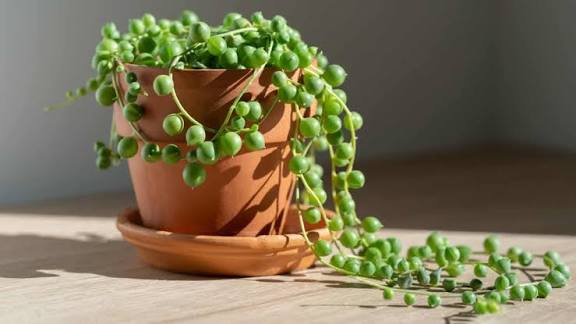If you’re looking for a beautiful, low-maintenance houseplant that adds instant charm to any space, the String of Pearls plant (Senecio rowleyanus) is a must-have. With its cascading strands of bead-like leaves, this succulent is a showstopper in hanging pots, window sills, and plant shelves. But like many succulents, it does have its quirks — and learning how to care for it properly makes all the difference between thriving vines and sad, shriveled strings.Don’t worry — this is your easy guide to how to care for a String of Pearls plant, step by step, so even beginner plant parents can keep it lush and happy!🌿 What Is a String of Pearls Plant?The String of Pearls is a trailing succulent native to southwest Africa. Its round, pearl-like leaves store water, helping it survive dry, sunny environments. These little green “beads” grow on long, slender stems that can trail over a foot long — perfect for hanging planters or shelves.When properly cared for, your plant will also reward you with small, white, cinnamon-scented flowers that bloom in late winter or early spring.☀️ Step 1: Find the Perfect LightWhen it comes to how to care for a String of Pearls plant, lighting is everything.Indoors: Place it near a bright window with plenty of indirect sunlight — a south- or west-facing window is ideal.Outdoors: Keep it in partial shade where it gets morning sun and afternoon shade.💡 Too little light? The pearls will become sparse and elongated.💡 Too much direct sun? The leaves may scorch or turn yellow.If your home doesn’t get enough natural light, you can supplement with a grow light to keep your plant full and vibrant year-round.💧 Step 2: Water SparinglyThe String of Pearls is a succulent — meaning it stores water in its leaves. The biggest mistake beginners make is overwatering.Watering Tips:Water only when the soil is completely dry.Check by sticking your finger an inch deep — if it feels dry, it’s time to water.Use the “soak and dry” method: Water thoroughly until it drains out the bottom, then wait for the soil to dry before watering again.In winter, water less often since the plant grows slowly.🚫 Avoid letting the plant sit in water — soggy soil causes root rot fast.🌱 Step 3: Use the Right SoilGood drainage is key to keeping your String of Pearls healthy.Best Soil Mix:2 parts cactus or succulent mix1 part perlite or coarse sand (for extra drainage)This ensures the roots get enough air and don’t stay wet for too long.If you’re repotting, always choose a pot with drainage holes — a decorative cover pot is fine as long as the inner pot drains freely.🌤️ Step 4: Keep It in the Right TemperatureString of Pearls prefers warm, dry air — much like its native habitat.Ideal temperature: 70–80°F (21–27°C) during the dayAt night: No lower than 50°F (10°C)Keep it away from cold drafts, air conditioners, or heating vents that can dry it out too quickly.If you live in a warm climate, you can move your plant outdoors in summer — just introduce it gradually to sunlight to prevent burns.🌸 Step 5: Feed It OccasionallyDuring the growing season (spring and summer), feed your String of Pearls plant about once a month.Use a diluted succulent fertilizer or a balanced houseplant fertilizer (at half strength). Avoid over-fertilizing — too many nutrients can harm the delicate roots.No need to feed in winter when the plant is resting.✂️ Step 6: Pruning and PropagationPruning:Trim long, leggy stems to encourage fuller growth. This helps your plant stay dense and healthy instead of thin and sparse.Propagation:Here’s the fun part — String of Pearls is super easy to propagate!Cut a few healthy strands about 4–6 inches long.Remove the bottom few pearls from each cutting.Lay them on moist succulent soil and press gently so the nodes touch the soil.Mist lightly every few days.Within 2–3 weeks, new roots will form — and soon, you’ll have a brand-new plant!🌸 Step 7: Encourage BloomingWith the right conditions, your String of Pearls will bloom with delicate white flowers that smell faintly of cinnamon or cloves.To encourage blooming:Give it plenty of bright light during the growing season.Allow it to rest in cooler temperatures (around 55–60°F / 13–16°C) in winter.Don’t overwater or over-fertilize.This natural rest period helps the plant build energy for flowering in spring.⚠️ Common Problems (and How to Fix Them)Even with easy care, your String of Pearls plant can show signs of stress. Here’s how to troubleshoot:Problem Likely Cause SolutionShriveled pearls Underwatering or too much sun Water thoroughly and move to bright, indirect lightMushy, black pearls Overwatering or poor drainage Let soil dry, trim rot, repot in fresh mixSparse growth Not enough light Move to a sunnier spotDrooping strands Root damage or water issues Check roots and adjust watering schedule🪴 Step 8: Repotting Your String of PearlsRepot your plant every 2–3 years or when it outgrows its pot. Spring is the best time to repot.When repotting:Gently remove the plant and shake off old soil.Check for any rotten roots and trim them.Replant in fresh succulent soil with good drainage.After repotting, wait a few days before watering to allow roots to heal.🌿 Bonus: Styling Ideas for String of PearlsThis trailing plant is a natural decor star! Try these ideas:Hang it in macramé planters near a bright window.Let it cascade over a bookshelf or tall plant stand.Combine it with other succulents like String of Hearts or Burro’s Tail for a lush, boho look.Its elegant drape and unique texture make it perfect for modern, minimal, or nature-inspired interiors.🌱 Final Thoughts: Make It Easy — How to Care for String of Pearls PlantCaring for a String of Pearls plant doesn’t have to be complicated. With bright light, occasional watering, and well-draining soil, this stunning succulent will reward you with lush green vines that grow longer every month.So if you’re ready to add a touch of whimsy and elegance to your home, start with this easy-care beauty. Follow these simple tips, stay patient, and watch your pearls flourish — one string at a time. 🌿💧✨

